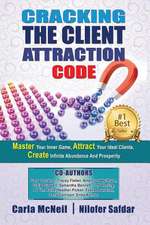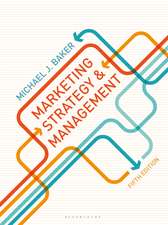Marketing Services: Competing Through Quality
Autor Leonard L. Berryen Limba Engleză Paperback – 15 apr 2004
Berry and Parasuraman show that inspired leadership, a customer-minded corporate culture, an excellent service-system design, and effective use of technology and information are crucial to superior service quality and services marketing. When a company's service is excellent, customers are more likely to perceive value in transactions, spread favorable word-of-mouth impressions, and respond positively to employee-cross-selling efforts. The authors point out that a service company that does relatively little pre-sales marketing but is truly dedicated to delivering excellent quality service will have greater marketing effectiveness, higher customer retention, and more sales to existing customers than a company that emphasizes pre-sale marketing but falls short during actual service delivery. The focus of any company, they insist, must be customer satisfaction through integration of service quality throughout the entire system.
Filled with examples, stories, and insights from senior executives, Berry and Parasuraman's new framework for effective marketing services contains the key to high-performance services marketing.
Preț: 98.53 lei
Nou
Puncte Express: 148
Preț estimativ în valută:
18.85€ • 19.74$ • 15.60£
18.85€ • 19.74$ • 15.60£
Carte disponibilă
Livrare economică 17-31 martie
Preluare comenzi: 021 569.72.76
Specificații
ISBN-13: 9780743267410
ISBN-10: 0743267419
Pagini: 228
Dimensiuni: 140 x 214 x 15 mm
Greutate: 0.28 kg
Editura: Free Press
Colecția Free Press
ISBN-10: 0743267419
Pagini: 228
Dimensiuni: 140 x 214 x 15 mm
Greutate: 0.28 kg
Editura: Free Press
Colecția Free Press
Notă biografică
Leonard L. Berry holds the JCPenney Chair of Retailing Studies at Texas A&M University, where he is also Professor of Marketing and Director of the Center for Retailing Studies.
Extras
Chapter 1
Services and Quality
A guest at the Holiday Inn on Union Square in San Francisco is attempting to turn on the radio in his room. No matter which button he pushes the radio will not play. Finally, the guest reports a defective radio. A hotel employee soon arrives at the guest's room with a new radio, a box of chocolates, and flowers. As for the radio already in the room, the employee turns it on without difficulty (it plays perfectly) and quickly reassures the guest that the radio is tricky to operate. The server shows the guest how to work the radio and pleasantly exits the room, leaving both radios, the chocolates, and the flowers.
An elderly woman is in her favorite food store, Ukrop's Super Markets of Richmond, Virginia. She picks up a large pineapple from the display case, holds it for several moments, and then returns it with obvious reluctance. Ukrop's president, James Ukrop, witnesses this scene and asks the customer if she would like to buy half of the pineapple, indicating that the store would be glad to cut it in half. The customer accepts and states how she looks forward to visiting Ukrop's because the staff is so friendly and makes her feel so welcome.
The manager of the downtown Chicago Marriott hotel discovers that two thirds of all guest calls to housekeeping are requests for ironing boards. This discovery leads to the idea of placing irons and ironing boards in each guest room. The problem is where to find the $20,000 this will cost. The hotel manager reviews the capital budget and notes that $22,000 is earmarked to replace black-and-white television sets with color sets in the bathrooms of concierge-level guest rooms. The manager inquires how many VIP guests have requested color television sets for their bathrooms and learns that no guest has ever made such a request. So the manager cancels plans to buy color sets and adds the irons and ironing boards. The result is no net addition to the capital budget, a big productivity boost for housekeeping, and an important new guest room feature.
Night after night, Aurora, Colorado, police officers answer calls for break-ins of cars parked outside a local dance hall. One officer notes that the burglaries usually involve purses and interviews female customers who say they lock their handbags in their parked cars, fearing the bags would be stolen from unattended tables during dances. The officer then persuades the dance hall owner to install lockers and the burglary calls drop from dozens each month to two in four months.
These four stories underscore our central argument in this book: the essence of services marketing is service. Service quality is the foundation of services marketing. The textbooks stress the four Ps of marketing -- product, place, promotion, and price -- but in a service business none of this works very well without a Q -- for quality.
The stories illustrate that cutting-edge services marketing is less the slick and fancy and more old-fashioned virtues such as caring and common sense. They illustrate the marketing power of doing the little things that competitors forget to do, from delivering flowers and chocolates with a radio to placing irons and ironing boards in the closets of hotel rooms. They illustrate the importance of customer-friendly service designs, such as outfitting a dance hall with lockers. Finally, the stories illustrate that everyone performing a service is a marketer, from a supermarket president who roams the store aisles to a hotel housekeeper who teaches guests how to operate a (poorly designed) radio.
Effective services marketing is a strong service concept delivered well, a desired service performed excellently. This synergy of strategy and execution fuels service industry builders and leaders, from Domino's Pizza to Cable News Network (CNN), from Federal Express to Walt Disney World, from ServiceMaster to Southwest Airlines. Each of these industry leaders reflects a special chemistry that combines a big idea and superior execution.
The big idea alone offers only a temporary advantage. Companies that pioneer successful new service concepts always face ambitious competitors unashamed to imitate. Pizza Hut had little choice but to add home-delivery service given the dynamic growth of Domino's. Federal Express's success ushered in a horde of new competitors -- and a climate of fierce price-cutting -- in the overnight mail business.
Superior execution is vital to sustaining the success initiated by an innovative service concept. An innovator's service quality is usually more difficult to imitate than its service concept. This is because quality service comes from inspired leadership throughout an organization, a customer-minded corporate culture, excellent service-system design, the effective use of information and technology, and other factors that develop slowly in a company, if at all. Entering the home-delivery pizza business is one matter. Performing this service as well as Domino's Pizza is quite another matter.
Service quality is the foundation for services marketing because the core product being marketed is a performance. The performance is the product; the performance is what customers buy. A strong service concept gives companies the opportunity to compete for customers; a strong performance of the service concept builds competitiveness by earning customers' confidence and reinforcing branding, advertising, selling, and pricing.
SERVICES MARKETING VERSUS GOODS MARKETING
In manufacturing, the marketing function plays (or should play) a dominant role in customer need identification and product development prior to production and in effecting product demand following production. Production precedes demand stimulation, which precedes consumption. Marketing's post-production roles include creating brand awareness, inducing brand trial, demonstrating brand benefits, and building brand preference. Customers assess the brand's promised benefits during consumption, strengthening or weakening brand preference accordingly.
The chronological sequence of the four functional phases are shown in Exhibit 1-1. It also delineates the contributions of postproduction marketing, consumption, and word-of-mouth communications -- spawned by other customers' experiences with the brand -- to brand awareness, trial, demonstration, and preference. The tangibility of goods and their visible demonstration enable the marketing department to perform effectively all four demand-stimulation roles prior to a customer's purchase commitment. Likewise, product tangibility can boost prospective customers' confidence in their own evaluation of goods, thereby lowering their reliance on word-of-mouth communications.
The limited promotional impact of word-of-mouth communications is signified by the thin-line arrows in Exhibit 1-1. When word-of-mouth communications do exert a strong influence on the purchase of goods -- automobiles and personal computers, for example -- it is usually because customers perceive difficulty in evaluating the product prior to purchase and perceive risk in making a mistake. In general, the more difficult it is for customers to evaluate salient aspects of a product prior to purchase, the stronger the potential influence of word-of-mouth communications and the more the product will need to be marketed like a service.
As Exhibit 1-2 shows, the nature and roles of marketing differ for services. Although both services marketing and goods marketing start with the critical need-identification and product design functions, goods generally are produced before sold and services generally are sold before produced. Moreover, services marketing has a more limited influence on customers prior to purchase than goods marketing. Whereas goods marketers may be able to move prospective customers from brand awareness to brand preference with packaging, promotion, pricing, and distribution, services marketers usually cannot.
Customers must experience the intangible service to really know it. Intangibility makes services more difficult for customers to imagine and desire than goods. Customers purchasing professional tax advice have no knobs to turn, buttons to push, or pictures to see. Customers' perception of risk tends to be high for services because services cannot be touched, smelled, tasted, or tried on before purchase. Customers can test-drive a new automobile and kick the tires, but to try a new vacation resort they must first register as guests.
Services are dominated by experience qualities, attributes that can be meaningfully evaluated only after purchase and during production-consumption. In services, both post-sale marketing through orchestrating a satisfying experience for customers during production and word-of-mouth communication (which is surrogate and supplement for customers' direct experiences) have prominent effects in winning customers' loyalty. Services marketers can create brand awareness and induce trial before the sale, but they demonstrate benefits and build brand preference most effectively after the sale.
Superior service cannot be manufactured in a factory, packaged, and delivered intact to customers. Instead, for many services customers actually enter the "factory" (the airport and airplane, for example) to consume the service as it is produced. The "producers" with whom customers interact, such as airline ticket agents, flight attendants, and baggage handlers, perform the dual role of "marketers." How service personnel conduct themselves in the customers' presence -- how they act, what they say, what they don't say, their overall appearance -- influences whether customers buy from the firm again.
If a worker in an appliance factory has an aloof attitude, is poorly dressed, or has body odor, the consumer will never know it because producer and consumer never meet. However, if a medical doctor has an aloof attitude, a restaurant waiter an unkempt appearance, or a taxi driver body odor, customer perceptions of the service are affected profoundly. A service company that does relatively little presale marketing but is truly dedicated to delivering excellent quality service will enjoy greater marketing effectiveness -- higher customer retention, more sales to existing customers, greater success at converting prospects to customers through positive word-of-mouth communications -- than a company emphasizing pre-sale marketing but falling short during actual service delivery.
SERVICES IN MANUFACTURING
Although comparing the nature and roles of goods and services marketing is useful, an easy dichotomy between manufacturing and service firms does not exist. In reality, service output is a major, if not the major, success factor for manufacturing companies.
One force pushing manufacturers toward more service-intensive operations is the greater potential for building sustainable competitive advantage through service rather than goods. Quinn, Doorley, and Paquette state the point well:
True strategic focus means that a company can concentrate more power in its chosen markets than anyone else can. Once this meant owning the largest resource base, manufacturing plants, research labs, or distribution channels to support product lines. Now physical facilities -- including a seemingly superior product -- seldom provide a sustainable competitive edge. They are too easily bypassed, reverse engineered, cloned, or slightly surpassed. Instead, a maintainable advantage usually derives from outstanding depth in selected human skills, logistics capabilities, knowledge bases, or other service strengths that competitors cannot reproduce and that lead to greater demonstrable value for the customer.
Smart manufacturing company executives are as interested in service quality as goods quality, in selling the intangibles as the tangibles, in entering new markets for services as entering new markets for goods. They recognize that the core benefit their customers buy is delivered not by a good or a service but by both. They view the synergy of tangible and intangible as the value-adding, differentiating output.
Manufacturers are service firms too, just less so than companies commonly considered to be service firms. If the source of a product's core benefit is more tangible than intangible, it would be considered a good. If the core benefit source is more intangible than tangible, it would be considered a service. However, virtually all products have both tangible and intangible elements that contribute to the core benefit. Value-conscious automobile buyers do not just buy the car; they buy a system of transportation that will give them their money's worth. Thus, a dealer's reputation for professional sales and service, spare parts availability, warranty protection, and other factors influence the selection of make and model.
Most companies operate within the dotted lines in Exhibit 1-3. And those firms now outside these lines may well move toward them in an effort to add value to and differentiate their products. A packaged food company, for example, might add toll-free telephone lines to provide information for customers, sponsor cooking schools, and offer recipe services. A babysitting service might take electronic games to the home for the children to enjoy.
In this book, we use the terms services marketing and goods marketing because there are differences. And we refer to service companies and to manufacturers because most companies are more one than the other. But we do submit that the lines of distinction between the manufacturing and service sectors are blurring and that the arena of consequence within manufacturing will increasingly be service.
AN INTEGRATIVE FRAMEWORK
We have written this book to present service quality and services marketing as one discipline. These are not separate disciplines or even allied disciplines. Rather, one (service quality) is a subset of the other (services marketing). In this book, we strive to capture in an integrated framework salient concepts of services marketing -- the concepts that matter most when the product is a performance -- and we attempt to take these ideas further than they have been taken before. Exhibit 1-4 presents the services marketing framework that we develop in this book. Chapters 2-4 concern the service quality foundation: service reliability ("Doing the Service Right the First Time"), service recovery ("Doing the Service Very Right the Second Time"), and strong interactive service ("Managing and Exceeding Customers' Expectations"). These chapters are based in part on research we have conducted since finishing our earlier book, Delivering Quality Service, written with our colleague, Valarie Zeithaml.
Chapter 5 ("Turning Marketing into a Line Function") concerns the primary roles of the marketing department in building a services marketing organization. Special emphasis is placed on creating marketing energy in the line organization closest to end-customers. Developing marketing skills and a customer-minded attitude among line employees helps a service company improve its service and maximize its marketing potential. In services, it is line employees who deliver the service promised or don't, cross-sell the service line or simply take orders, build the company's brand image or destroy it.
Chapter 6 ("Managing the Evidence") concerns turning tangibles in the service environment to advantage and Chapter 7 ("Branding the Company") concerns transforming the company itself into a powerful message. The intangibility of services makes evidence management and branding critical to services marketing success. New customers in particular are attentive to clues about the service because they have little or no other experience with the company on which to base their initial impressions. Hence, we place evidence management and branding in the marketing-to-new-customer box in our model, while making it quite clear in the chapters that the ideas also apply beyond new customer marketing.
Chapter 8 ("Marketing to Existing Customers") emphasizes the superior profit opportunities with current customers and discusses success factors in relationship marketing. Chapter 9 ("Marketing to Employees") presents the concept of employees as customers and discusses the success factors in internal marketing. Chapter 10 ("Services Marketing in the Nineties") reflects on how services marketing will be changing.
As our model suggests, services marketers must be effective with each customer type: new, existing, and internal. Service companies must first attract new customers if they are to build customer relationships. Firms must market to employees because they are the performers and the performance is the product. The model's arrows show the cross-influences at work in services marketing. Delivering quality service stimulates favorable word-of-mouth communications and helps a company attract more new customers, results in more satisfied existing customers, and provides a more fulfilling and rewarding work environment for internal customers. Conversely, firms that effectively manage evidence and branding, build customer relationships, and market internally will improve service in the process. The marketing department, in the middle of the model, builds a strong marketing organization by focusing its energies and resources on service improvement in particular, and on creating value for new, existing, and internal customers in general.
Copyright © 1991 by The Free Press
Services and Quality
A guest at the Holiday Inn on Union Square in San Francisco is attempting to turn on the radio in his room. No matter which button he pushes the radio will not play. Finally, the guest reports a defective radio. A hotel employee soon arrives at the guest's room with a new radio, a box of chocolates, and flowers. As for the radio already in the room, the employee turns it on without difficulty (it plays perfectly) and quickly reassures the guest that the radio is tricky to operate. The server shows the guest how to work the radio and pleasantly exits the room, leaving both radios, the chocolates, and the flowers.
An elderly woman is in her favorite food store, Ukrop's Super Markets of Richmond, Virginia. She picks up a large pineapple from the display case, holds it for several moments, and then returns it with obvious reluctance. Ukrop's president, James Ukrop, witnesses this scene and asks the customer if she would like to buy half of the pineapple, indicating that the store would be glad to cut it in half. The customer accepts and states how she looks forward to visiting Ukrop's because the staff is so friendly and makes her feel so welcome.
The manager of the downtown Chicago Marriott hotel discovers that two thirds of all guest calls to housekeeping are requests for ironing boards. This discovery leads to the idea of placing irons and ironing boards in each guest room. The problem is where to find the $20,000 this will cost. The hotel manager reviews the capital budget and notes that $22,000 is earmarked to replace black-and-white television sets with color sets in the bathrooms of concierge-level guest rooms. The manager inquires how many VIP guests have requested color television sets for their bathrooms and learns that no guest has ever made such a request. So the manager cancels plans to buy color sets and adds the irons and ironing boards. The result is no net addition to the capital budget, a big productivity boost for housekeeping, and an important new guest room feature.
Night after night, Aurora, Colorado, police officers answer calls for break-ins of cars parked outside a local dance hall. One officer notes that the burglaries usually involve purses and interviews female customers who say they lock their handbags in their parked cars, fearing the bags would be stolen from unattended tables during dances. The officer then persuades the dance hall owner to install lockers and the burglary calls drop from dozens each month to two in four months.
These four stories underscore our central argument in this book: the essence of services marketing is service. Service quality is the foundation of services marketing. The textbooks stress the four Ps of marketing -- product, place, promotion, and price -- but in a service business none of this works very well without a Q -- for quality.
The stories illustrate that cutting-edge services marketing is less the slick and fancy and more old-fashioned virtues such as caring and common sense. They illustrate the marketing power of doing the little things that competitors forget to do, from delivering flowers and chocolates with a radio to placing irons and ironing boards in the closets of hotel rooms. They illustrate the importance of customer-friendly service designs, such as outfitting a dance hall with lockers. Finally, the stories illustrate that everyone performing a service is a marketer, from a supermarket president who roams the store aisles to a hotel housekeeper who teaches guests how to operate a (poorly designed) radio.
Effective services marketing is a strong service concept delivered well, a desired service performed excellently. This synergy of strategy and execution fuels service industry builders and leaders, from Domino's Pizza to Cable News Network (CNN), from Federal Express to Walt Disney World, from ServiceMaster to Southwest Airlines. Each of these industry leaders reflects a special chemistry that combines a big idea and superior execution.
The big idea alone offers only a temporary advantage. Companies that pioneer successful new service concepts always face ambitious competitors unashamed to imitate. Pizza Hut had little choice but to add home-delivery service given the dynamic growth of Domino's. Federal Express's success ushered in a horde of new competitors -- and a climate of fierce price-cutting -- in the overnight mail business.
Superior execution is vital to sustaining the success initiated by an innovative service concept. An innovator's service quality is usually more difficult to imitate than its service concept. This is because quality service comes from inspired leadership throughout an organization, a customer-minded corporate culture, excellent service-system design, the effective use of information and technology, and other factors that develop slowly in a company, if at all. Entering the home-delivery pizza business is one matter. Performing this service as well as Domino's Pizza is quite another matter.
Service quality is the foundation for services marketing because the core product being marketed is a performance. The performance is the product; the performance is what customers buy. A strong service concept gives companies the opportunity to compete for customers; a strong performance of the service concept builds competitiveness by earning customers' confidence and reinforcing branding, advertising, selling, and pricing.
SERVICES MARKETING VERSUS GOODS MARKETING
In manufacturing, the marketing function plays (or should play) a dominant role in customer need identification and product development prior to production and in effecting product demand following production. Production precedes demand stimulation, which precedes consumption. Marketing's post-production roles include creating brand awareness, inducing brand trial, demonstrating brand benefits, and building brand preference. Customers assess the brand's promised benefits during consumption, strengthening or weakening brand preference accordingly.
The chronological sequence of the four functional phases are shown in Exhibit 1-1. It also delineates the contributions of postproduction marketing, consumption, and word-of-mouth communications -- spawned by other customers' experiences with the brand -- to brand awareness, trial, demonstration, and preference. The tangibility of goods and their visible demonstration enable the marketing department to perform effectively all four demand-stimulation roles prior to a customer's purchase commitment. Likewise, product tangibility can boost prospective customers' confidence in their own evaluation of goods, thereby lowering their reliance on word-of-mouth communications.
The limited promotional impact of word-of-mouth communications is signified by the thin-line arrows in Exhibit 1-1. When word-of-mouth communications do exert a strong influence on the purchase of goods -- automobiles and personal computers, for example -- it is usually because customers perceive difficulty in evaluating the product prior to purchase and perceive risk in making a mistake. In general, the more difficult it is for customers to evaluate salient aspects of a product prior to purchase, the stronger the potential influence of word-of-mouth communications and the more the product will need to be marketed like a service.
As Exhibit 1-2 shows, the nature and roles of marketing differ for services. Although both services marketing and goods marketing start with the critical need-identification and product design functions, goods generally are produced before sold and services generally are sold before produced. Moreover, services marketing has a more limited influence on customers prior to purchase than goods marketing. Whereas goods marketers may be able to move prospective customers from brand awareness to brand preference with packaging, promotion, pricing, and distribution, services marketers usually cannot.
Customers must experience the intangible service to really know it. Intangibility makes services more difficult for customers to imagine and desire than goods. Customers purchasing professional tax advice have no knobs to turn, buttons to push, or pictures to see. Customers' perception of risk tends to be high for services because services cannot be touched, smelled, tasted, or tried on before purchase. Customers can test-drive a new automobile and kick the tires, but to try a new vacation resort they must first register as guests.
Services are dominated by experience qualities, attributes that can be meaningfully evaluated only after purchase and during production-consumption. In services, both post-sale marketing through orchestrating a satisfying experience for customers during production and word-of-mouth communication (which is surrogate and supplement for customers' direct experiences) have prominent effects in winning customers' loyalty. Services marketers can create brand awareness and induce trial before the sale, but they demonstrate benefits and build brand preference most effectively after the sale.
Superior service cannot be manufactured in a factory, packaged, and delivered intact to customers. Instead, for many services customers actually enter the "factory" (the airport and airplane, for example) to consume the service as it is produced. The "producers" with whom customers interact, such as airline ticket agents, flight attendants, and baggage handlers, perform the dual role of "marketers." How service personnel conduct themselves in the customers' presence -- how they act, what they say, what they don't say, their overall appearance -- influences whether customers buy from the firm again.
If a worker in an appliance factory has an aloof attitude, is poorly dressed, or has body odor, the consumer will never know it because producer and consumer never meet. However, if a medical doctor has an aloof attitude, a restaurant waiter an unkempt appearance, or a taxi driver body odor, customer perceptions of the service are affected profoundly. A service company that does relatively little presale marketing but is truly dedicated to delivering excellent quality service will enjoy greater marketing effectiveness -- higher customer retention, more sales to existing customers, greater success at converting prospects to customers through positive word-of-mouth communications -- than a company emphasizing pre-sale marketing but falling short during actual service delivery.
SERVICES IN MANUFACTURING
Although comparing the nature and roles of goods and services marketing is useful, an easy dichotomy between manufacturing and service firms does not exist. In reality, service output is a major, if not the major, success factor for manufacturing companies.
One force pushing manufacturers toward more service-intensive operations is the greater potential for building sustainable competitive advantage through service rather than goods. Quinn, Doorley, and Paquette state the point well:
True strategic focus means that a company can concentrate more power in its chosen markets than anyone else can. Once this meant owning the largest resource base, manufacturing plants, research labs, or distribution channels to support product lines. Now physical facilities -- including a seemingly superior product -- seldom provide a sustainable competitive edge. They are too easily bypassed, reverse engineered, cloned, or slightly surpassed. Instead, a maintainable advantage usually derives from outstanding depth in selected human skills, logistics capabilities, knowledge bases, or other service strengths that competitors cannot reproduce and that lead to greater demonstrable value for the customer.
Smart manufacturing company executives are as interested in service quality as goods quality, in selling the intangibles as the tangibles, in entering new markets for services as entering new markets for goods. They recognize that the core benefit their customers buy is delivered not by a good or a service but by both. They view the synergy of tangible and intangible as the value-adding, differentiating output.
Manufacturers are service firms too, just less so than companies commonly considered to be service firms. If the source of a product's core benefit is more tangible than intangible, it would be considered a good. If the core benefit source is more intangible than tangible, it would be considered a service. However, virtually all products have both tangible and intangible elements that contribute to the core benefit. Value-conscious automobile buyers do not just buy the car; they buy a system of transportation that will give them their money's worth. Thus, a dealer's reputation for professional sales and service, spare parts availability, warranty protection, and other factors influence the selection of make and model.
Most companies operate within the dotted lines in Exhibit 1-3. And those firms now outside these lines may well move toward them in an effort to add value to and differentiate their products. A packaged food company, for example, might add toll-free telephone lines to provide information for customers, sponsor cooking schools, and offer recipe services. A babysitting service might take electronic games to the home for the children to enjoy.
In this book, we use the terms services marketing and goods marketing because there are differences. And we refer to service companies and to manufacturers because most companies are more one than the other. But we do submit that the lines of distinction between the manufacturing and service sectors are blurring and that the arena of consequence within manufacturing will increasingly be service.
AN INTEGRATIVE FRAMEWORK
We have written this book to present service quality and services marketing as one discipline. These are not separate disciplines or even allied disciplines. Rather, one (service quality) is a subset of the other (services marketing). In this book, we strive to capture in an integrated framework salient concepts of services marketing -- the concepts that matter most when the product is a performance -- and we attempt to take these ideas further than they have been taken before. Exhibit 1-4 presents the services marketing framework that we develop in this book. Chapters 2-4 concern the service quality foundation: service reliability ("Doing the Service Right the First Time"), service recovery ("Doing the Service Very Right the Second Time"), and strong interactive service ("Managing and Exceeding Customers' Expectations"). These chapters are based in part on research we have conducted since finishing our earlier book, Delivering Quality Service, written with our colleague, Valarie Zeithaml.
Chapter 5 ("Turning Marketing into a Line Function") concerns the primary roles of the marketing department in building a services marketing organization. Special emphasis is placed on creating marketing energy in the line organization closest to end-customers. Developing marketing skills and a customer-minded attitude among line employees helps a service company improve its service and maximize its marketing potential. In services, it is line employees who deliver the service promised or don't, cross-sell the service line or simply take orders, build the company's brand image or destroy it.
Chapter 6 ("Managing the Evidence") concerns turning tangibles in the service environment to advantage and Chapter 7 ("Branding the Company") concerns transforming the company itself into a powerful message. The intangibility of services makes evidence management and branding critical to services marketing success. New customers in particular are attentive to clues about the service because they have little or no other experience with the company on which to base their initial impressions. Hence, we place evidence management and branding in the marketing-to-new-customer box in our model, while making it quite clear in the chapters that the ideas also apply beyond new customer marketing.
Chapter 8 ("Marketing to Existing Customers") emphasizes the superior profit opportunities with current customers and discusses success factors in relationship marketing. Chapter 9 ("Marketing to Employees") presents the concept of employees as customers and discusses the success factors in internal marketing. Chapter 10 ("Services Marketing in the Nineties") reflects on how services marketing will be changing.
As our model suggests, services marketers must be effective with each customer type: new, existing, and internal. Service companies must first attract new customers if they are to build customer relationships. Firms must market to employees because they are the performers and the performance is the product. The model's arrows show the cross-influences at work in services marketing. Delivering quality service stimulates favorable word-of-mouth communications and helps a company attract more new customers, results in more satisfied existing customers, and provides a more fulfilling and rewarding work environment for internal customers. Conversely, firms that effectively manage evidence and branding, build customer relationships, and market internally will improve service in the process. The marketing department, in the middle of the model, builds a strong marketing organization by focusing its energies and resources on service improvement in particular, and on creating value for new, existing, and internal customers in general.
Copyright © 1991 by The Free Press
Cuprins
Contents
Acknowledgments
Authors' Note
PART ONE
An Integrative Framework for Marketing Services
1. Services and Quality
PART TWO
Quality: The Foundation for Services Marketing
2. Doing the Service Right the First Time
3. Doing the Service Very Right the Second Time
4. Managing and Exceeding Customers' Expectations
PART THREE
Building a Services Marketing Organization
5. Turning Marketing into a Line Function
PART FOUR
Maximizing Services Marketing Potential
6. Managing the Evidence
7. Branding the Company
8. Marketing to Existing Customers
9. Marketing to Employees
PART FIVE
Peering Ahead
10. Services Marketing in the Nineties
Notes
Index


























